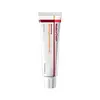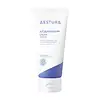What's inside
What's inside
 Key Ingredients
Key Ingredients

 Benefits
Benefits

 Concerns
Concerns

 Ingredients Side-by-side
Ingredients Side-by-side

Lactis Proteinum Extract
Skin ConditioningDipropylene Glycol
HumectantHydrogenated Polydecene
EmollientCapric Acid
CleansingCaprylic/Capric Triglyceride
MaskingGlycerin
HumectantGlyceryl Stearate
EmollientPentaerythrityl Tetraethylhexanoate
EmollientNiacinamide
SmoothingCyclohexasiloxane
EmollientCetyl Alcohol
EmollientPolyglyceryl-6 Distearate
EmulsifyingWater
Skin ConditioningDicaprylyl Ether
EmollientVinyldimethicone
Asiaticoside
AntioxidantMadecassic Acid
Skin ConditioningBoric Acid
AntimicrobialMadecassoside
AntioxidantPolypeptide-1
Skin ConditioningHydrolyzed Hyaluronic Acid
HumectantMelaleuca Viminalis Extract
Inula Racemosa Root Extract
Skin ConditioningPalau White Clay Extract
HumectantMacadamia Ternifolia Seed Oil
EmollientDonkey Oil
EmollientHydrogenated Lecithin
EmulsifyingSodium Hyaluronate
HumectantPolyglyceryl-10 Laurate
Skin ConditioningStearyl Alcohol
EmollientBeeswax
Emulsion StabilisingXylitylglucoside
Humectant2-Hydroxyethyl Acrylate
Sodium Acryloyldimethyltaurate Crosspolymer
Emulsion StabilisingJojoba Esters
EmollientAnhydroxylitol
HumectantPolyglyceryl-3 Beeswax
Emulsifying1,2-Hexanediol
Skin ConditioningHydroxyacetophenone
AntioxidantXylitol
HumectantMethylpropanediol
SolventPropanediol
SolventGlucose
HumectantXanthan Gum
EmulsifyingEthoxydiglycol
HumectantDisodium Azelate
Adenosine
Skin ConditioningSorbitan Isostearate
EmulsifyingEthylhexylglycerin
Skin ConditioningSodium Laurate
CleansingCyclodextrin
AbsorbentLauric Acid
CleansingSodium Polyacrylate
AbsorbentPvp
Emulsion StabilisingPvm/Ma Copolymer
Emulsion StabilisingOctyldodecanol
EmollientGlycolide
HumectantCaffeine
Skin ConditioningC12-13 Alketh-9
EmulsifyingCollagen Amino Acids
MoisturisingCeramide EOP
Skin ConditioningResveratrol
AntioxidantArginine
MaskingGlycol
HumectantEctoin
Skin ConditioningTaurine
BufferingHydrolyzed Elastin
EmollientRetinol
Skin ConditioningMaltodextrin
AbsorbentPhytosphingosine
Skin ConditioningSucrose Stearate
EmollientSodium Dna
Skin ConditioningCyanocobalamin
Skin ConditioningGlycine
BufferingGlutamic Acid
HumectantHelianthus Annuus Seed
Skin ConditioningPolyglycerin-3
HumectantTocopherol
AntioxidantArtemisia Vulgaris Extract
Skin ConditioningVanilla Planifolia Fruit Extract
Skin ConditioningOlea Europaea Fruit Oil
MaskingOrange Roughy Oil
Skin ConditioningCitrus Aurantium Dulcis Peel Oil
MaskingLavandula Angustifolia Oil
MaskingCitrus Aurantium Bergamia Fruit Oil
MaskingRosmarinus Officinalis Leaf Oil
MaskingFruit Fly Larva Oil
EmollientCurcuma Aromatica Root Oil
Skin ConditioningAbies Balsamea Bark Oil
MaskingRosa Centifolia Flower Oil
MaskingMarmot Oil
Rosa Damascena Flower Oil
MaskingPelargonium Graveolens Oil
MaskingMyroxylon Pereirae Resin
MaskingLinalool
PerfumingLimonene
PerfumingPinus Mugo Leaf Oil
MaskingLactis Proteinum Extract, Dipropylene Glycol, Hydrogenated Polydecene, Capric Acid, Caprylic/Capric Triglyceride, Glycerin, Glyceryl Stearate, Pentaerythrityl Tetraethylhexanoate, Niacinamide, Cyclohexasiloxane, Cetyl Alcohol, Polyglyceryl-6 Distearate, Water, Dicaprylyl Ether, Vinyldimethicone, Asiaticoside, Madecassic Acid, Boric Acid, Madecassoside, Polypeptide-1, Hydrolyzed Hyaluronic Acid, Melaleuca Viminalis Extract, Inula Racemosa Root Extract, Palau White Clay Extract, Macadamia Ternifolia Seed Oil, Donkey Oil, Hydrogenated Lecithin, Sodium Hyaluronate, Polyglyceryl-10 Laurate, Stearyl Alcohol, Beeswax, Xylitylglucoside, 2-Hydroxyethyl Acrylate, Sodium Acryloyldimethyltaurate Crosspolymer, Jojoba Esters, Anhydroxylitol, Polyglyceryl-3 Beeswax, 1,2-Hexanediol, Hydroxyacetophenone, Xylitol, Methylpropanediol, Propanediol, Glucose, Xanthan Gum, Ethoxydiglycol, Disodium Azelate, Adenosine, Sorbitan Isostearate, Ethylhexylglycerin, Sodium Laurate, Cyclodextrin, Lauric Acid, Sodium Polyacrylate, Pvp, Pvm/Ma Copolymer, Octyldodecanol, Glycolide, Caffeine, C12-13 Alketh-9, Collagen Amino Acids, Ceramide EOP, Resveratrol, Arginine, Glycol, Ectoin, Taurine, Hydrolyzed Elastin, Retinol, Maltodextrin, Phytosphingosine, Sucrose Stearate, Sodium Dna, Cyanocobalamin, Glycine, Glutamic Acid, Helianthus Annuus Seed, Polyglycerin-3, Tocopherol, Artemisia Vulgaris Extract, Vanilla Planifolia Fruit Extract, Olea Europaea Fruit Oil, Orange Roughy Oil, Citrus Aurantium Dulcis Peel Oil, Lavandula Angustifolia Oil, Citrus Aurantium Bergamia Fruit Oil, Rosmarinus Officinalis Leaf Oil, Fruit Fly Larva Oil, Curcuma Aromatica Root Oil, Abies Balsamea Bark Oil, Rosa Centifolia Flower Oil, Marmot Oil, Rosa Damascena Flower Oil, Pelargonium Graveolens Oil, Myroxylon Pereirae Resin, Linalool, Limonene, Pinus Mugo Leaf Oil
Water
Skin ConditioningButylene Glycol
HumectantGlycerin
HumectantButylene Glycol Dicaprylate/Dicaprate
EmollientCetyl Ethylhexanoate
EmollientSqualane
EmollientPentaerythrityl Tetraisostearate
EmollientDicaprylyl Carbonate
EmollientBehenyl Alcohol
EmollientDimethicone
EmollientHydroxypropyl Bispalmitamide Mea
EmollientStearic Acid
CleansingBetaine
HumectantMannitol
HumectantC14-22 Alcohols
Emulsion StabilisingPalmitic Acid
EmollientHydroxypropyl Bislauramide Mea
EmollientArachidyl Alcohol
EmollientCholesterol
EmollientPolyacrylate-13
C12-20 Alkyl Glucoside
EmulsifyingAllantoin
Skin ConditioningArachidyl Glucoside
EmulsifyingNiacinamide
SmoothingCeramide NP
Skin ConditioningGlyceryl Caprylate
EmollientEthylhexylglycerin
Skin ConditioningHydrogenated Polyisobutene
EmollientCarbomer
Emulsion StabilisingTromethamine
BufferingDimethiconol
EmollientPolyglyceryl-10 Laurate
Skin ConditioningHydrogenated Lecithin
EmulsifyingEthylhexyl Palmitate
EmollientAcrylates/Ammonium Methacrylate Copolymer
Sorbitan Isostearate
EmulsifyingSilica
AbrasivePhytosphingosine
Skin ConditioningSphingolipids
EmollientArachidic Acid
CleansingTocopherol
AntioxidantOleic Acid
EmollientWater, Butylene Glycol, Glycerin, Butylene Glycol Dicaprylate/Dicaprate, Cetyl Ethylhexanoate, Squalane, Pentaerythrityl Tetraisostearate, Dicaprylyl Carbonate, Behenyl Alcohol, Dimethicone, Hydroxypropyl Bispalmitamide Mea, Stearic Acid, Betaine, Mannitol, C14-22 Alcohols, Palmitic Acid, Hydroxypropyl Bislauramide Mea, Arachidyl Alcohol, Cholesterol, Polyacrylate-13, C12-20 Alkyl Glucoside, Allantoin, Arachidyl Glucoside, Niacinamide, Ceramide NP, Glyceryl Caprylate, Ethylhexylglycerin, Hydrogenated Polyisobutene, Carbomer, Tromethamine, Dimethiconol, Polyglyceryl-10 Laurate, Hydrogenated Lecithin, Ethylhexyl Palmitate, Acrylates/Ammonium Methacrylate Copolymer, Sorbitan Isostearate, Silica, Phytosphingosine, Sphingolipids, Arachidic Acid, Tocopherol, Oleic Acid
 Reviews
Reviews

Ingredients Explained
These ingredients are found in both products.
Ingredients higher up in an ingredient list are typically present in a larger amount.
Ethylhexylglycerin (we can't pronounce this either) is commonly used as a preservative and skin softener. It is derived from glyceryl.
You might see Ethylhexylglycerin often paired with other preservatives such as phenoxyethanol. Ethylhexylglycerin has been found to increase the effectiveness of these other preservatives.
Glycerin is already naturally found in your skin. It helps moisturize and protect your skin.
A study from 2016 found glycerin to be more effective as a humectant than AHAs and hyaluronic acid.
As a humectant, it helps the skin stay hydrated by pulling moisture to your skin. The low molecular weight of glycerin allows it to pull moisture into the deeper layers of your skin.
Hydrated skin improves your skin barrier; Your skin barrier helps protect against irritants and bacteria.
Glycerin has also been found to have antimicrobial and antiviral properties. Due to these properties, glycerin is often used in wound and burn treatments.
In cosmetics, glycerin is usually derived from plants such as soybean or palm. However, it can also be sourced from animals, such as tallow or animal fat.
This ingredient is organic, colorless, odorless, and non-toxic.
Glycerin is the name for this ingredient in American English. British English uses Glycerol/Glycerine.
Learn more about GlycerinHydrogenated Lecithin is created from the hydrogenation of lecithin (a group of phospholipids). Hydrogenation is a chemical reaction between hydrogen and another element.
This ingredient is an emollient and emulsifier. As an emollient, it helps soften skin by trapping moisture within. As an emulsifier, it prevents oil and water ingredients from separating.
Niacinamide is a multitasking form of vitamin B3 that strengthens the skin barrier, reduces pores and dark spots, regulates oil, and improves signs of aging.
And the best part? It's gentle and well-tolerated by most skin types, including sensitive and reactive skin.
You might have heard of "niacin flush", or the reddening of skin that causes itchiness. Niacinamide has not been found to cause this.
In very rare cases, some individuals may not be able to tolerate niacinamide at all or experience an allergic reaction to it.
If you are experiencing flaking, irritation, and dryness with this ingredient, be sure to double check all your products as this ingredient can be found in all categories of skincare.
When incorporating niacinamide into your routine, look out for concentration amounts. Typically, 5% niacinamide provides benefits such as fading dark spots. However, if you have sensitive skin, it is better to begin with a smaller concentration.
When you apply niacinamide to your skin, your body converts it into nicotinamide adenine dinucleotide (NAD). NAD is an essential coenzyme that is already found in your cells as "fuel" and powers countless biological processes.
In your skin, NAD helps repair cell damage, produce new healthy cells, support collagen production, strengthen the skin barrier, and fight environmental stressors (like UV and pollution).
Our natural NAD levels start to decline with age, leading to slower skin repair, visible aging, and a weaker skin barrier. By providing your skin niacinamide, you're recharging your skin's NAD levels. This leads to stronger, healthier, and younger looking skin.
Another name for vitamin B3 is nicotinamide. This vitamin is water-soluble and our bodies don't store it. We obtain Vitamin B3 from either food or skincare. Meat, fish, wheat, yeast, and leafy greens contain vitamin B3.
The type of niacinamide used in skincare is synthetically created.
Learn more about NiacinamidePhytosphingosine is a phospholipid naturally found in our skin as a building block for ceramides.. It helps moisturize, soothe, and protect skin.
Phytosphingosine contributes to your skin's natural moisturizing factor (NMF). The NMF is responsible for hydration, a strong barrier, and plasticity. Our NMF decreases with age. Increasing NMF leads to more healthy and hydrated skin.
Studies show products formulated with NMF ingredients help strengthen our skin's barrier. Having a healthy skin barrier reduces irritation and increases hydration. Our skin barrier is responsible for having plump and firm skin. It also helps protect our skin against infection, allergies, and inflammation.
Fun fact: Phytosphingosine is abundant in plants and fungi.
More ingredients that help boost collagen in skin:
Learn more about PhytosphingosinePolyglyceryl-10 Laurate is an ester of lauric acid and Polyglycerin-10.
Polyglyceryl-10 Laurate is a cleansing agent and emulsifier. It helps gather dirt, oil, and other pollutants to be rinsed away. As an emulsifier, it helps prevent ingredients from separating, such as oil and water.
Polyglyceryl-10 Laurate may not be fungal acne safe.
Learn more about Polyglyceryl-10 LaurateSorbitan Isostearate is an emulsifer and cleaning agent. It is created from isostearic acid and sorbitol.
As an emulsifier, Sorbitan Isostearate prevents oils and water from separating.
Due to its isostearic acid base, it may not be safe for Malassezia or fungal acne.
Learn more about Sorbitan IsostearateTocopherol (also known as Vitamin E) is a common antioxidant used to help protect the skin from free-radicals and strengthen the skin barrier. It's also fat soluble - this means our skin is great at absorbing it.
Vitamin E also helps keep your natural skin lipids healthy. Your lipid skin barrier naturally consists of lipids, ceramides, and fatty acids. Vitamin E offers extra protection for your skin’s lipid barrier, keeping your skin healthy and nourished.
Another benefit is a bit of UV protection. Vitamin E helps reduce the damage caused by UVB rays. (It should not replace your sunscreen). Combining it with Vitamin C can decrease sunburned cells and hyperpigmentation after UV exposure.
You might have noticed Vitamin E + C often paired together. This is because it is great at stabilizing Vitamin C. Using the two together helps increase the effectiveness of both ingredients.
There are often claims that Vitamin E can reduce/prevent scarring, but these claims haven't been confirmed by scientific research.
Learn more about TocopherolWater. It's the most common cosmetic ingredient of all. You'll usually see it at the top of ingredient lists, meaning that it makes up the largest part of the product.
So why is it so popular? Water most often acts as a solvent - this means that it helps dissolve other ingredients into the formulation.
You'll also recognize water as that liquid we all need to stay alive. If you see this, drink a glass of water. Stay hydrated!
Learn more about Water